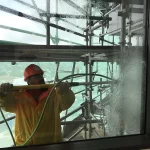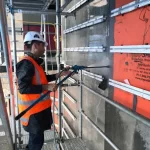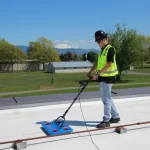Acoustic Beamforming: A Cutting-Edge Method for Locating Air Leakages in Building Envelopes
The quest for improved energy efficiency and occupant comfort in buildings has led experts to explore innovative diagnostic tools. The traditional methods of detecting air leakages are often costly and time-consuming. However, advancements in acoustic methodologies have recently shown tremendous potential in enhancing the efficiency and accuracy of these tests. This article reviews a specific study and discusses the implications of using acoustic beamforming for leak detection in building envelopes.
Introduction to Acoustic Beamforming in Building Science
Acoustic beamforming is a sophisticated, noninvasive, sound-based method increasingly being recognised for its effectiveness in detecting air leakages. By utilising arrays of highly sensitive microphones, this technology captures minute sounds emitted by air escaping through leaks that might otherwise go undetected.
Insights from Recent Research
A recent paper by Schirircke, Diel, and Kölsch illustrates this method’s capabilities. Their study, titled “Field Testing of an Acoustic Method for Locating Air Leakages in Building Envelopes,” and can be accessed [here]. This research highlights the practical application of acoustic beamforming in real-world scenarios, providing valuable insights into its efficacy and potential.
Study Overview
The researchers evaluated the effectiveness of acoustic signals for detecting air leaks, using third-octave frequency bands in kHz to analyse the spectral characteristics of the sounds. Beamforming techniques were employed to localise and visualise potential leaks, distinguishing between different types of leaks and enhancing the understanding of a building’s airtightness.
Advantages of Acoustic Beamforming
Localisation and Visualisation: One of the standout benefits of using acoustic beamforming is its ability to localise and visually represent where leaks are occurring precisely. This specificity allows for targeted repairs, improving the structure’s energy efficiency.
Non-Invasive and Efficient: This method circumvents the need for physical interventions like those required in blower door testing, which is traditionally labour-intensive and disruptive. Acoustic beamforming offers a streamlined, efficient approach significantly reducing testing times and associated costs.
Differentiation of Leak Types: By analysing the acoustic data’s spectral properties, leak types can be differentiated, whether they stem from structural flaws or inadequate seals. This level of detail is crucial for implementing the most effective remediation measures.
Limitations and Considerations
Despite its advantages, acoustic beamforming is not without its challenges:
False Positives: The leak detection accuracy can be compromised by ambient noises, which might lead to false positives. A detailed analysis and skilled interpretation of data are essential to differentiate between actual leaks and misleading noises.
Limited Frequency Range: The current focus on third-octave frequency bands means some leaks might not be detected if they emit sounds outside this range. Ongoing research and technological enhancements are needed to broaden the frequency range covered by this methodology.
Environmental Impact: Environmental variables such as wind, temperature, and noise levels can affect the method’s effectiveness, necessitating controlled conditions for optimal results.
Architectural Variety and Its Challenges
The efficacy of acoustic beamforming technology can be significantly influenced by architectural diversity, which varies widely across building designs and materials. Buildings come in an array of shapes, sizes, and constructions, each introducing unique challenges for acoustic testing:
Complex Geometry: Buildings with intricate designs, such as those with curved walls, elaborate facades, and varying angles, can create complex echo patterns and reverberations. These acoustic reflections can interfere with the clarity of the signals detected by beamforming technology, potentially masking the sound of leaks or creating false positives.
Material diversity: Different materials have varying acoustic properties — for instance, dense materials like concrete reflect sound waves more than porous materials like wood. This variation can affect how sound waves travel and dissipate, thus influencing the detection and accuracy of beamforming systems used to locate leaks.
Facade Depth and Features: Architectural features such as balconies, columns, and deep window recesses can create shadow zones that are hard for acoustic waves to penetrate effectively. These features can obscure or deflect sound waves generated by air leaks, making them harder to detect or accurately locate with standard beamforming setups.
Scale and Proximity: The size of the building and the spacing between its features can also impact acoustic beamforming. Larger buildings may require more sophisticated setups with greater numbers of microphones or specialized equipment to cover the entire facade effectively.
Adapting Beamforming Techniques to Architectural Diversity
Given the diversity in architectural designs, adapting and customizing beamforming techniques is essential for effective leak detection:
Array Configuration: Adjusting the microphone array configuration to suit specific facade geometries can help improve the capture of sound data. For buildings with complex designs, using more densely spaced microphone arrays may enhance the detection capabilities.
Signal Processing Algorithms: Developing and employing advanced signal processing algorithms that can filter out noise and reverberations typical to different materials and designs can lead to more accurate leakage detection.
Site-Specific Calibration: Before conducting a beamforming test, calibrating the equipment to the specific acoustic properties of the building can help in minimizing errors. This might include preliminary tests to understand how sound behaves within the unique architectural context of each building.
Use of Complementary Technologies: Integrating other technologies like thermal imaging or airflow measurements with acoustic beamforming can provide a more comprehensive analysis, especially in complex architectural settings. This multimodal approach can help confirm the presence of leaks detected acoustically and provide additional data points for more accurate location pinpointing.
The success of acoustic beamforming in detecting air leakages in building facades significantly depends on the architectural diversity of the structures being examined. By understanding and adapting to the unique acoustic challenges presented by different building designs and materials, the technician can enhance the accuracy and reliability of leak detection. Future research and technology development in acoustic beamforming should continue to focus on addressing these challenges, tailoring approaches to accommodate the broad spectrum of architectural forms encountered in modern and historic buildings alike.
Integrating acoustic beamforming into the toolkit for facade testing and leak detection represents a significant advancement in building diagnostics. As demonstrated in the study by Schiricke et al. and further discussed in the review of acoustic methodologies, this approach enhances the localisation, visualisation, and differentiation of air leakages. It is vital to acknowledge and address the inherent limitations of this technology. However, further refinement and research promise to enhance its utility, making it an indispensable asset in building envelope diagnostics in the future.
- Man using weather-tightness testing on window for quality assurance purposes
- Water inside on window sill after a water test failure
- onsite water test
- Building enclosure services, AAMA testing, AAMA 501, WGANZ, AAMA 502
- Horizontal ELD waterproof membrane testing
- Vertical ELD waterproof membrane testing
At this stage, Rommel has yet to introduce this technology to our toolkit, we keenly watch advancements in building leak detection to see where the technology may lead. Reach out to the team at Rommel today to discuss your building project – whether your project is a new build which requires quality assurance, or, an existing building with water ingress issues, we have the equipment and expertise to help you achieve the required outcomes.
Schiricke B, Diel M, Kölsch B. Field Testing of an Acoustic Method for Locating Air Leakages in Building Envelopes. Buildings. 2024; 14(4):1159. https://doi.org/10.3390/buildings14041159







